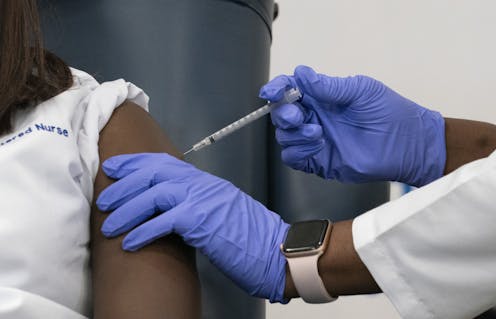How many lives have coronavirus vaccines saved? We used state data on deaths and vaccination rates to find out
- Written by Sumedha Gupta, Associate Professor of Economics, IUPUI
 CC BY-ND[1]
More than 200 million U.S. residents have gotten at least one shot of a COVID-19 vaccine with the expectation that the vaccines slow virus transmission and save lives.
Researchers know the efficacy of the vaccines from large-scale clinical trials[2], the gold standard for medical research. The studies found the vaccines to be very effective at preventing severe COVID–19[3] and especially good at preventing death[4]. But it’s important to track any new treatment in the real world as the population-level benefits of vaccines could differ from the efficacy found in clinical trials[5].
For instance, some people in the U.S. have only been getting the first shot[6] of a two-shot vaccine and are therefore less protected than a fully vaccinated person[7]. Alternatively, vaccinated people are much less likely to transmit COVID-19 to others[8], including those who are not vaccinated. This could make vaccines more effective at a population level than in the clinical trials.
I am a health economist[9], and my team and I have been studying the effects of public policy interventions like vaccination have had on the pandemic. We wanted to know how many lives vaccines may have saved due to the states’ COVID-19 vaccination campaigns in the U.S.
Building an accurate model
In March 2021, when weekly data on state COVID-19 vaccinations started to become reliably available from state agencies, my team began to analyze the association between state vaccination rates and the subsequent COVID-19 cases and deaths in each state. Our goal was to build a model that was accurate enough to measure the effect of vaccination within the complicated web of factors that influence COVID–19 deaths.
CC BY-ND[1]
More than 200 million U.S. residents have gotten at least one shot of a COVID-19 vaccine with the expectation that the vaccines slow virus transmission and save lives.
Researchers know the efficacy of the vaccines from large-scale clinical trials[2], the gold standard for medical research. The studies found the vaccines to be very effective at preventing severe COVID–19[3] and especially good at preventing death[4]. But it’s important to track any new treatment in the real world as the population-level benefits of vaccines could differ from the efficacy found in clinical trials[5].
For instance, some people in the U.S. have only been getting the first shot[6] of a two-shot vaccine and are therefore less protected than a fully vaccinated person[7]. Alternatively, vaccinated people are much less likely to transmit COVID-19 to others[8], including those who are not vaccinated. This could make vaccines more effective at a population level than in the clinical trials.
I am a health economist[9], and my team and I have been studying the effects of public policy interventions like vaccination have had on the pandemic. We wanted to know how many lives vaccines may have saved due to the states’ COVID-19 vaccination campaigns in the U.S.
Building an accurate model
In March 2021, when weekly data on state COVID-19 vaccinations started to become reliably available from state agencies, my team began to analyze the association between state vaccination rates and the subsequent COVID-19 cases and deaths in each state. Our goal was to build a model that was accurate enough to measure the effect of vaccination within the complicated web of factors that influence COVID–19 deaths.
















